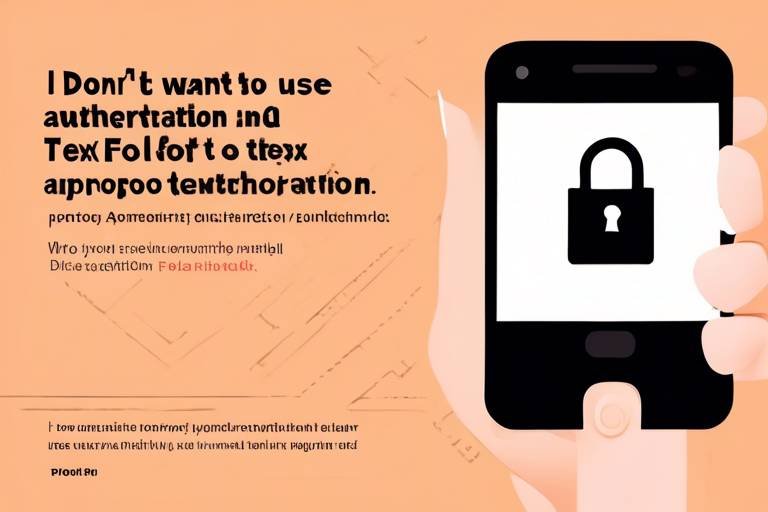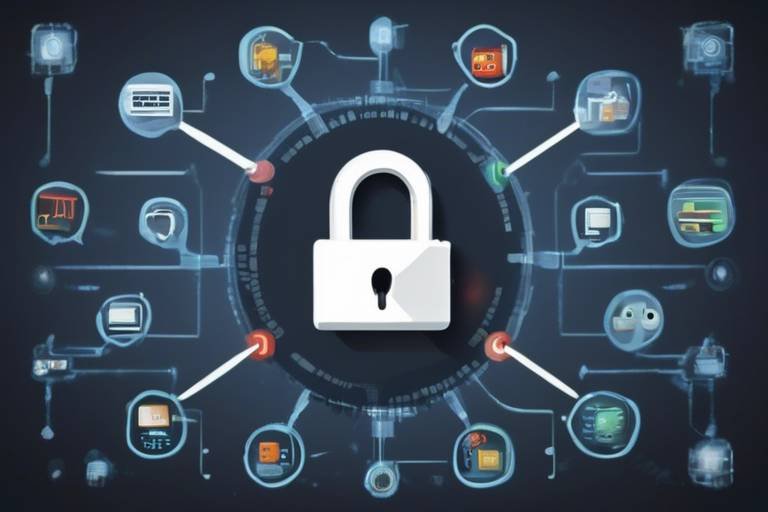Avoiding Online Scams - Techniques to Know
In today's digital age, where we rely heavily on the internet for everything from shopping to socializing, the threat of online scams looms larger than ever. It’s like walking through a bustling marketplace; while there are countless opportunities, there are also lurking dangers waiting to catch the unsuspecting. This article explores various techniques to help individuals recognize and avoid online scams, ensuring safer online experiences. By learning essential tips and strategies, you can protect yourself from fraudulent activities that could lead to financial loss or identity theft.
Online scams come in various forms, including phishing, identity theft, and advance-fee fraud. Recognizing these scams is the first step towards prevention and protection against financial loss. Imagine being in a maze full of deceitful paths; understanding the different types of scams is like having a map that guides you safely to your destination. Whether it’s an enticing email promising a fortune or a social media message from a “friend” asking for help, knowing what to look for can make all the difference.
Phishing is a common tactic used by scammers to steal personal information. It’s akin to a wolf in sheep's clothing, where a seemingly innocent email or message hides malicious intent. Understanding how to identify phishing emails and messages can significantly reduce your risk of falling victim to these schemes. Think of it as a game of detective; the more clues you gather, the better your chances of solving the case before it’s too late.
Suspicious emails often contain generic greetings and urgent requests that tug at your emotions. For instance, an email that starts with “Dear Customer” instead of your name should raise a red flag. Learning to spot these red flags can help you avoid engaging with potential scammers and protect your personal data. Remember, legitimate companies usually address you by your name and will never pressure you into making quick decisions.
Always verify the sender’s email address before clicking on any links. Scammers often use addresses that closely resemble legitimate ones, making it crucial to scrutinize the details carefully. For example, an email from “support@yourbank.com” could easily be faked as “support@yourb4nk.com.” A small change can make a big difference, so take the time to look closely.
Before clicking on links or downloading attachments, hover over them to reveal their true destination. This simple action can help you avoid malicious sites designed to steal your information. If the link looks suspicious or doesn’t match the context of the email, it’s best to steer clear. Think of it as checking the ingredients before tasting a dish; you wouldn’t want to consume something that could be harmful.
Scammers often use social engineering tactics to manipulate victims. They play on your emotions, fear, or curiosity to get what they want. Understanding these techniques can help you remain vigilant and protect your sensitive information from unauthorized access. Imagine a magician performing tricks; while they may seem impressive, knowing how the trick is done can prevent you from being fooled.
Protecting your personal information is vital in avoiding scams. Implementing strategies to safeguard your data can significantly reduce your vulnerability to online fraud. Just as you would lock your doors at home, you need to take similar precautions online. Here are some effective strategies:
Creating strong, unique passwords for each account is essential. This practice can help prevent unauthorized access and protect your personal information from being compromised. Think of your password as the key to your house; the stronger it is, the harder it is for intruders to break in. Avoid using easily guessable passwords like “123456” or “password,” and consider using a password manager to keep track of your credentials.
Two-factor authentication adds an extra layer of security to your accounts. By requiring a second form of verification, it makes it more difficult for scammers to gain access to your sensitive information. Imagine having a double lock on your door; even if someone has the key, they still can’t get in without the second lock being opened. This simple yet effective measure can be the difference between security and vulnerability.
- What should I do if I suspect an email is a scam? If you suspect an email is a scam, do not click any links or download attachments. Report it to your email provider and delete it.
- How can I tell if a website is secure? Look for "https://" in the URL and a padlock icon in the address bar. These indicate that the site is secure.
- What are some common signs of a phishing attempt? Common signs include generic greetings, urgent requests, and suspicious email addresses.
- Is it safe to use public Wi-Fi for online banking? It is not recommended. Use a VPN or avoid accessing sensitive information on public networks.

Understanding Online Scams
This article explores various techniques to help individuals recognize and avoid online scams, ensuring safer online experiences. Learn essential tips and strategies to protect yourself from fraudulent activities.
Online scams are like the digital wolves in sheep's clothing, lurking in the shadows of the internet, waiting for unsuspecting victims to fall into their traps. They come in many forms, each designed to trick you into giving away your hard-earned money or personal information. From phishing emails that mimic legitimate businesses to elaborate schemes like identity theft and advance-fee fraud, these scams are evolving rapidly, making it crucial for everyone to stay informed.
Recognizing these scams is the first step towards prevention and protection against financial loss. Imagine walking through a dark alley; you wouldn't do it without being aware of your surroundings, right? The same principle applies online. By understanding the various tactics employed by scammers, you can arm yourself with the knowledge necessary to navigate the internet safely. Here are some common types of online scams you should be aware of:
- Phishing: This involves fraudulent emails or messages that appear to come from reputable sources, tricking you into revealing personal information.
- Identity Theft: Scammers steal your personal information to impersonate you, often leading to financial loss.
- Advance-Fee Fraud: You might receive a message claiming you've won a prize, but first, you need to pay a fee to claim it. Spoiler alert: you never win anything.
As you can see, the landscape of online scams is vast and varied. They often prey on emotions, creating a sense of urgency or fear to push you into making hasty decisions. For example, a common tactic is to send an email that claims your bank account has been compromised, urging you to click a link to resolve the issue. This is where the danger lies, as clicking that link could lead you straight into the hands of a scammer.
Moreover, online scams aren't just limited to emails; they can also manifest through social media, websites, and even phone calls. Scammers are incredibly resourceful and can adapt their methods to fit different platforms. Therefore, staying informed about the latest scams is essential. Regularly checking reliable sources and being skeptical of unsolicited communications can save you from becoming another statistic.
In conclusion, understanding online scams is about more than just recognizing a few warning signs. It's about cultivating a mindset of vigilance and skepticism. Always ask yourself: Is this too good to be true? By doing so, you can significantly enhance your safety online and protect your personal information from those who would exploit it.
Here are some common questions people have about online scams:
- What should I do if I think I've been scammed? If you suspect you've fallen victim to a scam, immediately change your passwords, report the incident to your bank, and contact local authorities.
- How can I report a scam? Most countries have a dedicated website or hotline for reporting scams. In the U.S., you can report to the Federal Trade Commission (FTC).
- Are all online scams easy to spot? Unfortunately, no. Some scams are very sophisticated and can be challenging to identify. Always remain cautious and skeptical.

Identifying Phishing Attempts
Phishing is like a digital fishing expedition where scammers cast their lines into the vast ocean of the internet, hoping to reel in unsuspecting victims. These fraudsters are crafty, often disguising themselves as trusted entities to steal your personal information. But don't worry! By honing your ability to identify phishing attempts, you can become a vigilant guardian of your sensitive data. Recognizing the signs of phishing is your first line of defense against these deceitful tactics.
One of the most common ways scammers try to hook you is through suspicious emails. These emails may look legitimate at first glance but often contain subtle red flags. For instance, they might have generic greetings like "Dear Customer" instead of your name. Additionally, they frequently include urgent requests, making you feel like you need to act immediately. Think about it: if a bank or a service you use needed urgent information, wouldn't they address you by name? Always take a moment to pause and reflect on the legitimacy of such communications.
When you receive an email that raises your suspicions, it's crucial to take a closer look. Checking the sender’s email address is a vital step in this process. Scammers are notorious for using addresses that closely resemble those of legitimate companies. For instance, instead of "support@yourbank.com," they might use "support@yourb4nk.com." A small difference, but it can lead to significant consequences! Always scrutinize the details carefully before taking any action.
Moreover, be cautious with links and attachments. Before clicking on any link, it's wise to analyze the URL. You can do this by hovering over the link to reveal its true destination. If the URL looks suspicious or doesn't match the context of the email, it's best to steer clear. Similarly, attachments can harbor malware, so think twice before downloading anything from an unknown source. Remember, a moment of caution can save you from a world of trouble!
Phishing isn't just about emails; it often involves social engineering techniques designed to manipulate you into revealing personal information. Scammers may pose as tech support, claiming they need your password to fix a supposed issue with your account. They might even create a sense of urgency, making you feel like you have to act fast. Understanding these tactics is essential. Be skeptical of unsolicited communications, and never share your personal information unless you are absolutely certain of the recipient's identity.
In conclusion, identifying phishing attempts is a crucial skill in today's digital landscape. By being aware of the signs of suspicious emails, verifying sender addresses, analyzing links, and recognizing social engineering tactics, you can significantly reduce your risk of falling victim to these scams. Stay informed, stay alert, and remember: when in doubt, it's always best to double-check!
Q: What should I do if I think I've received a phishing email?
A: If you suspect an email is phishing, do not click on any links or download attachments. Report it to your email provider and delete it immediately.
Q: Can phishing attempts occur through text messages?
A: Yes, phishing can also occur through SMS, known as "smishing." Be cautious of any unsolicited messages asking for personal information.
Q: How can I protect myself from phishing?
A: Use strong passwords, enable two-factor authentication, and stay educated about the latest phishing tactics to protect yourself effectively.

Recognizing Suspicious Emails
This article explores various techniques to help individuals recognize and avoid online scams, ensuring safer online experiences. Learn essential tips and strategies to protect yourself from fraudulent activities.
Online scams come in various forms, including phishing, identity theft, and advance-fee fraud. Recognizing these scams is the first step towards prevention and protection against financial loss.
Phishing is a common tactic used by scammers to steal personal information. Understanding how to identify phishing emails and messages can significantly reduce your risk of falling victim to these schemes.
When it comes to spotting online scams, is like having a radar that alerts you to danger. These emails often come disguised as legitimate communications but carry hidden threats. One of the first things to look out for is the greeting. If the email starts with a generic salutation like "Dear Customer" instead of your name, that's a big red flag. Legitimate companies usually address you by your name, as they have your information on file.
Another common tactic used by scammers is to create a sense of urgency. They might say something like, "Your account will be suspended unless you act now!" This kind of language is designed to provoke an emotional response, pushing you to act quickly without thinking. Always take a step back and consider whether the request makes sense. Is it a legitimate reason for urgency, or are they trying to catch you off guard?
Moreover, the email address of the sender is crucial. Scammers often use addresses that look similar to those of legitimate companies. For example, instead of "example@legitcompany.com," they might use "example@legitcompanie.com" with an extra "e" or a different domain altogether. Always verify the sender’s email address before clicking on any links or downloading attachments.
Speaking of links, another tactic employed by scammers is to disguise malicious links. Before clicking, hover over any link to see the actual URL. If it looks suspicious or doesn't match the company's official website, do not click it! Additionally, be wary of attachments. If you receive an unexpected attachment from someone you know, verify with them first before opening it, as their account may have been compromised.
In summary, recognizing suspicious emails involves a mix of common sense and vigilance. Always be skeptical of unsolicited messages that request personal information or prompt you to act quickly. By staying aware of these tactics, you can significantly reduce your risk of falling victim to online scams.
Protecting your personal information is vital in avoiding scams. Implementing strategies to safeguard your data can significantly reduce your vulnerability to online fraud.
Creating strong, unique passwords for each account is essential. This practice can help prevent unauthorized access and protect your personal information from being compromised.
Two-factor authentication adds an extra layer of security to your accounts. By requiring a second form of verification, it makes it more difficult for scammers to gain access to your sensitive information.
- What should I do if I receive a suspicious email?
If you receive a suspicious email, do not click on any links or download attachments. Instead, report it to your email provider and delete it. - How can I tell if a website is secure?
Look for "https://" in the URL and a padlock icon in the address bar, which indicates that the site uses encryption to protect your data. - Is it safe to use public Wi-Fi for online banking?
Public Wi-Fi networks can be risky. Avoid accessing sensitive accounts unless you are using a secure VPN.

Checking Email Addresses
This article explores various techniques to help individuals recognize and avoid online scams, ensuring safer online experiences. Learn essential tips and strategies to protect yourself from fraudulent activities.
Online scams come in various forms, including phishing, identity theft, and advance-fee fraud. Recognizing these scams is the first step towards prevention and protection against financial loss.
Phishing is a common tactic used by scammers to steal personal information. Understanding how to identify phishing emails and messages can significantly reduce your risk of falling victim to these schemes.
Suspicious emails often contain generic greetings and urgent requests. Learning to spot these red flags can help you avoid engaging with potential scammers and protect your personal data.
One of the most critical steps in identifying phishing attempts is checking the sender's email address. Scammers are notorious for using email addresses that look strikingly similar to those of legitimate companies or individuals. For instance, instead of support@bank.com, they might use support@bank-secure.com. This slight alteration can be easy to overlook, especially when you're in a rush or your attention is diverted. To ensure you’re not being duped, always take a moment to scrutinize the sender’s email address before clicking on any links or responding.
Here are a few tips to help you verify email addresses:
- Look for misspellings: Many scam emails include typos or unusual characters. If the domain name is misspelled, it’s likely a scam.
- Check the domain: Legitimate companies usually use their official domain. Always ensure that the domain matches the company’s website.
- Search for the email online: If you’re unsure, a quick internet search can reveal if others have flagged the email as suspicious.
Additionally, if the email claims to be from a well-known organization and asks for sensitive information, it's a major red flag. Legitimate companies typically do not request personal information through email. If in doubt, contact the organization directly using a verified contact method to confirm the legitimacy of the email.
Before clicking on links or downloading attachments, hover over them to reveal their true destination. This simple action can help you avoid malicious sites designed to steal your information.
Scammers often use social engineering tactics to manipulate victims. Understanding these techniques can help you remain vigilant and protect your sensitive information from unauthorized access.
Protecting your personal information is vital in avoiding scams. Implementing strategies to safeguard your data can significantly reduce your vulnerability to online fraud.
Creating strong, unique passwords for each account is essential. This practice can help prevent unauthorized access and protect your personal information from being compromised.
Two-factor authentication adds an extra layer of security to your accounts. By requiring a second form of verification, it makes it more difficult for scammers to gain access to your sensitive information.
Q: How can I tell if an email is legitimate?
A: Always check the sender's email address for discrepancies, look for unusual language or requests for personal information, and verify through official channels if in doubt.
Q: What should I do if I suspect an email is a scam?
A: Do not click on any links or download attachments. Report the email to your email provider and the organization it claims to be from.
Q: Is it safe to use the same password for multiple accounts?
A: No, using the same password increases your risk. If one account is compromised, all others using the same password are vulnerable.
Q: What is two-factor authentication?
A: It's a security process that requires two different forms of identification before granting access to an account, adding an extra layer of protection.

Analyzing Links and Attachments
This article explores various techniques to help individuals recognize and avoid online scams, ensuring safer online experiences. Learn essential tips and strategies to protect yourself from fraudulent activities.
Online scams come in various forms, including phishing, identity theft, and advance-fee fraud. Recognizing these scams is the first step towards prevention and protection against financial loss.
Phishing is a common tactic used by scammers to steal personal information. Understanding how to identify phishing emails and messages can significantly reduce your risk of falling victim to these schemes.
Suspicious emails often contain generic greetings and urgent requests. Learning to spot these red flags can help you avoid engaging with potential scammers and protect your personal data.
Always verify the sender’s email address before clicking on any links. Scammers often use addresses that closely resemble legitimate ones, making it crucial to scrutinize the details carefully.
When it comes to online safety, is as vital as checking the sender's email address. Scammers often embed malicious links or attachments in their communications, cleverly disguised to look like legitimate content. Before you click on any link, take a moment to hover your cursor over it. This simple action will reveal the actual URL, allowing you to assess whether it's a safe site or a phishing attempt. If the link looks suspicious or doesn’t match the context of the email, it’s best to avoid clicking it altogether.
Attachments can be even more dangerous. They may contain malware designed to infiltrate your device and steal your information. If you receive an attachment from an unknown sender or if the email seems out of character for someone you know, think twice before opening it. Consider using a scanning tool to check attachments for viruses and malware before downloading them.
Here are some additional tips to keep in mind when analyzing links and attachments:
- Look for HTTPS: Ensure the link starts with 'https://' rather than 'http://'. The 's' indicates a secure connection.
- Check for Typos: Scammers often use URLs with subtle misspellings or extra characters. Be vigilant!
- Use Link Scanners: Websites like VirusTotal can help you analyze links before you click on them.
By being cautious and employing these strategies, you can significantly reduce your risk of falling victim to online scams.
Protecting your personal information is vital in avoiding scams. Implementing strategies to safeguard your data can significantly reduce your vulnerability to online fraud.
Creating strong, unique passwords for each account is essential. This practice can help prevent unauthorized access and protect your personal information from being compromised.
Two-factor authentication adds an extra layer of security to your accounts. By requiring a second form of verification, it makes it more difficult for scammers to gain access to your sensitive information.
Q: What should I do if I think I've encountered a scam?
A: If you suspect you've encountered a scam, do not engage further. Report it to the relevant authorities, such as the FTC or your local consumer protection agency.
Q: How can I report phishing emails?
A: You can report phishing emails to your email provider and forward them to the Anti-Phishing Working Group at reportphishing@apwg.org.
Q: Is it safe to click on links in emails from known contacts?
A: Even if the email is from someone you know, be cautious. Their account may have been compromised. Always verify with the sender through another method before clicking.
Q: What are some signs of a legitimate website?
A: Look for contact information, a privacy policy, and reviews or testimonials. A secure website will also have 'https://' in the URL.

Recognizing Social Engineering Techniques
Social engineering is a sly and manipulative tactic that scammers use to exploit human psychology rather than technical vulnerabilities. Imagine a magician performing a trick; they distract you with one hand while the other hand is doing something sneaky. In the same way, social engineers create scenarios that make you lower your guard, often leading you to divulge sensitive information or perform actions that compromise your security. By understanding the common techniques used in social engineering, you can arm yourself against these deceptive practices.
One of the most prevalent techniques involves pretexting, where the scammer creates a fabricated scenario to obtain information. For instance, they might pose as a bank representative and claim they need to verify your account for security reasons. This scenario can feel legitimate, especially if they use specific details that make their story believable. Always remember, if someone is asking for sensitive information unexpectedly, it’s okay to be skeptical.
Another common tactic is baiting, where a scammer entices you with something appealing, such as free software or a tempting offer, to lure you into a trap. For example, you might receive an email about a free download that promises to enhance your computer's performance. However, once you click on it, you could be downloading malware instead. It's crucial to be cautious about offers that seem too good to be true, as they often are.
Additionally, tailgating is a physical social engineering technique where an unauthorized person gains access to a restricted area by following someone who is authorized. This can happen in workplaces where security measures are in place. Always be aware of your surroundings and ensure that you are not being followed into secure areas by someone who shouldn't be there.
To help you better understand these techniques, here’s a quick overview:
| Technique | Description |
|---|---|
| Pretexting | Creating a fabricated scenario to obtain information. |
| Baiting | Enticing with attractive offers to lure victims into traps. |
| Tailgating | Gaining unauthorized access by following someone authorized. |
Finally, it’s essential to stay informed about the latest social engineering tactics. Scammers are constantly evolving their methods, and being aware of these changes can help you stay one step ahead. Remember, if something feels off or too urgent, take a moment to pause and evaluate the situation. Trust your instincts; they can be your best defense against these manipulative techniques.
- What should I do if I think I’ve been a victim of social engineering?
Immediately change your passwords, notify your bank or relevant institutions, and monitor your accounts for suspicious activity. - How can I educate myself about new scams?
Follow reputable cybersecurity blogs, subscribe to newsletters, and engage with community forums focused on online safety. - Is it safe to share personal information online?
Be cautious; only share personal information with trusted sources and always verify the legitimacy of requests.

Safeguarding Personal Information
In today's digital age, safeguarding your personal information is not just a good practice; it's absolutely essential. With the increasing number of online scams, it’s vital to take proactive measures to protect your data. Think of your personal information as a treasure chest; if you leave it unguarded, it’s only a matter of time before a thief tries to break in. So, how can you ensure that your treasure remains safe? Let’s dive into some effective strategies that can help you keep your personal information secure.
First and foremost, using strong passwords is crucial. A strong password is like a robust lock on your treasure chest. It should be a mix of letters, numbers, and special characters. Avoid using easily guessable information such as your name or birthday. Instead, consider using a password manager to generate and store complex passwords for each of your accounts. This way, you won’t have to remember them all, and you’ll significantly reduce the risk of unauthorized access.
Next up is the importance of enabling two-factor authentication (2FA). This security measure acts like a double lock on your treasure chest. Even if a scammer manages to get hold of your password, they would still need that second form of verification to access your account. This could be a code sent to your mobile device or an authentication app. By implementing 2FA, you add an extra layer of protection that can be a game-changer in safeguarding your personal data.
Moreover, it’s essential to be cautious about the information you share online. In this digital world, oversharing can make you an easy target for scammers. Think before you post. Even seemingly harmless details can be pieced together to form a profile that could be exploited. For instance, if you share your pet’s name, your mother’s maiden name, and your birthdate, a scammer could potentially use that information to answer security questions and gain access to your accounts.
Additionally, regularly reviewing your privacy settings on social media platforms is a smart move. Ensure that your profiles are set to private and that you control who can see your information. It’s like drawing curtains over your treasure chest; it keeps prying eyes away from your valuable assets. Be wary of friend requests from unknown individuals, as they may be trying to gather information about you.
Lastly, it’s vital to stay informed about the latest scams and phishing tactics. Knowledge is power! By educating yourself about common scams, you can spot red flags more easily. For example, if you receive an email claiming you’ve won a prize but need to provide personal information to claim it, that’s a major warning sign. Remember, if something seems too good to be true, it probably is.
In summary, safeguarding your personal information involves a combination of creating strong passwords, enabling two-factor authentication, being cautious about what you share online, reviewing privacy settings, and staying informed. By implementing these strategies, you can significantly reduce your vulnerability to online scams and keep your treasure chest secure.
- What is the best way to create a strong password? A strong password should be at least 12 characters long and include a mix of uppercase letters, lowercase letters, numbers, and special characters.
- Why is two-factor authentication important? Two-factor authentication adds an extra layer of security, making it more difficult for unauthorized users to access your accounts even if they have your password.
- How can I tell if a website is secure? Look for "https://" at the beginning of the URL and a padlock icon in the address bar, indicating that the site uses encryption to protect your data.
- What should I do if I think I’ve been scammed? Immediately change your passwords, enable two-factor authentication, and report the scam to the relevant authorities.

Using Strong Passwords
This article explores various techniques to help individuals recognize and avoid online scams, ensuring safer online experiences. Learn essential tips and strategies to protect yourself from fraudulent activities.
Online scams come in various forms, including phishing, identity theft, and advance-fee fraud. Recognizing these scams is the first step towards prevention and protection against financial loss.
Phishing is a common tactic used by scammers to steal personal information. Understanding how to identify phishing emails and messages can significantly reduce your risk of falling victim to these schemes.
Suspicious emails often contain generic greetings and urgent requests. Learning to spot these red flags can help you avoid engaging with potential scammers and protect your personal data.
Always verify the sender’s email address before clicking on any links. Scammers often use addresses that closely resemble legitimate ones, making it crucial to scrutinize the details carefully.
Before clicking on links or downloading attachments, hover over them to reveal their true destination. This simple action can help you avoid malicious sites designed to steal your information.
Scammers often use social engineering tactics to manipulate victims. Understanding these techniques can help you remain vigilant and protect your sensitive information from unauthorized access.
Protecting your personal information is vital in avoiding scams. Implementing strategies to safeguard your data can significantly reduce your vulnerability to online fraud.
Creating strong, unique passwords for each account is essential. This practice can help prevent unauthorized access and protect your personal information from being compromised. Think of your password as the front door to your virtual home; if it’s weak, you might as well leave it wide open for intruders. A strong password should typically be at least 12-16 characters long and include a mix of uppercase letters, lowercase letters, numbers, and special symbols. For example, instead of using a simple password like "password123," consider something more complex like "P@ssw0rd!2023".
Moreover, it’s crucial to avoid using easily guessable information, such as birthdays or common words. Scammers often utilize software that can crack weak passwords within minutes. To help you understand the importance of strong passwords, consider the following table:
| Password Strength | Example | Estimated Time to Crack |
|---|---|---|
| Weak | password123 | Seconds |
| Moderate | Passw0rd!2023 | Minutes |
| Strong | 7$tr0ngP@ssw0rd#2023! | Years |
Additionally, consider using a password manager to help keep track of your complex passwords. These tools can generate strong passwords for you and store them securely, so you don’t have to remember each one. This way, you can have unique passwords for every account without the hassle of memorization. Ultimately, the effort you put into creating strong passwords can be the difference between a secure online experience and falling victim to a scam.
- What constitutes a strong password? A strong password is typically at least 12 characters long, includes a mix of letters, numbers, and symbols, and avoids using easily guessed information.
- How often should I change my passwords? It’s recommended to change your passwords every 3-6 months, or immediately if you suspect a breach.
- Can I use the same password for multiple accounts? No, using the same password across multiple accounts increases the risk of a security breach.

Enabling Two-Factor Authentication
This article explores various techniques to help individuals recognize and avoid online scams, ensuring safer online experiences. Learn essential tips and strategies to protect yourself from fraudulent activities.
Online scams come in various forms, including phishing, identity theft, and advance-fee fraud. Recognizing these scams is the first step towards prevention and protection against financial loss.
Phishing is a common tactic used by scammers to steal personal information. Understanding how to identify phishing emails and messages can significantly reduce your risk of falling victim to these schemes.
Suspicious emails often contain generic greetings and urgent requests. Learning to spot these red flags can help you avoid engaging with potential scammers and protect your personal data.
Always verify the sender’s email address before clicking on any links. Scammers often use addresses that closely resemble legitimate ones, making it crucial to scrutinize the details carefully.
Before clicking on links or downloading attachments, hover over them to reveal their true destination. This simple action can help you avoid malicious sites designed to steal your information.
Scammers often use social engineering tactics to manipulate victims. Understanding these techniques can help you remain vigilant and protect your sensitive information from unauthorized access.
Protecting your personal information is vital in avoiding scams. Implementing strategies to safeguard your data can significantly reduce your vulnerability to online fraud.
Creating strong, unique passwords for each account is essential. This practice can help prevent unauthorized access and protect your personal information from being compromised.
Enabling two-factor authentication (2FA) is one of the most effective ways to enhance your online security. This method requires not just a password and username but also something that only the user has on them, such as a physical device or a temporary code sent to their mobile phone. By implementing 2FA, you add an extra layer of protection that makes it significantly harder for scammers to gain access to your accounts, even if they manage to steal your password.
To enable two-factor authentication, you typically need to follow a few simple steps:
- Log into your account settings.
- Look for the security settings or options related to account security.
- Select the option to enable two-factor authentication.
- Choose your preferred method of receiving the second form of verification, such as an SMS, email, or an authentication app.
Once you have enabled 2FA, you will receive a code whenever you attempt to log in from a new device or location. This means that even if someone has your password, they won't be able to access your account without that additional code. Think of it like having a lock and a deadbolt on your front door—just having one isn't enough to keep intruders out, but together, they provide a much stronger barrier.
Moreover, many platforms now offer backup codes, which you should store in a safe place. These codes can be used if you lose access to your primary method of receiving verification codes, ensuring that you never get locked out of your own account.
Q: What is two-factor authentication?
A: Two-factor authentication is a security process that requires two different forms of identification to access an account, typically a password and a code sent to your device.
Q: Why is two-factor authentication important?
A: It adds an additional layer of security, making it much harder for unauthorized users to access your accounts, even if they have your password.
Q: How do I enable two-factor authentication?
A: You can enable it through your account settings on most platforms, where you will find options to set up your preferred method of receiving verification codes.
Q: What if I lose access to my two-factor authentication method?
A: Most services provide backup codes that you can use to regain access, so it's important to keep those in a safe place.
Frequently Asked Questions
- What are the most common types of online scams?
Online scams can take many forms, including phishing, identity theft, advance-fee fraud, and fake online stores. Each type has its own tactics, but they all aim to trick you into giving away personal information or money.
- How can I identify a phishing email?
Phishing emails often have generic greetings, urgent requests for personal information, and poor grammar. Always check the sender's email address and be cautious of links and attachments. If something feels off, it probably is!
- What should I do if I suspect an email is a scam?
If you think an email is a scam, do not click on any links or download attachments. Instead, report it to your email provider and delete it. You can also verify the sender by contacting them through a different channel.
- How can I protect my personal information online?
To safeguard your personal information, use strong and unique passwords for each account, enable two-factor authentication, and be cautious about sharing personal details on social media. Remember, if it sounds too good to be true, it probably is!
- What is two-factor authentication and why should I use it?
Two-factor authentication (2FA) adds an extra layer of security by requiring a second form of verification, such as a text message code, in addition to your password. This makes it much harder for scammers to access your accounts, even if they have your password.
- Can I recover my money if I fall victim to an online scam?
Recovering money lost to online scams can be challenging, but it’s not impossible. You should report the scam to your bank or credit card company immediately, as they may be able to reverse the transaction. Additionally, report the scam to authorities to help prevent others from falling victim.
- How can I stay updated on the latest scams?
Staying informed about the latest scams is crucial. You can subscribe to newsletters from cybersecurity organizations, follow news outlets, or join online forums where users share their experiences and tips on avoiding scams.



















